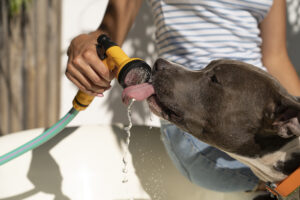As summer progresses, ensuring the safety of pets during a heat wave is crucial as cats, dogs, and other furry and flying critters are susceptible to heat-related illnesses just like their human family members.
Here are some tips to keep your pets safe and comfortable during hot weather:
- Always Provide Fresh Water.
Ensure your pet has access to clean, fresh water at all times, especially during hot weather when they can easily become dehydrated. If your pet spends time indoors and outdoors, place water bowls in both locations to encourage hydration.
- Avoid Overexertion.
Schedule walks and playtime during the cooler parts of the day, such as early morning or late evening and take it easy. Keep an eye out for signs of overheating. If your pet pants excessively, drools excessively, or seems weak, it’s time to stop and find a cooler place.
- Provide Shade and Ventilation.
Ensure your pet has access to shaded areas, whether they are indoors or outdoors. Direct sunlight can quickly overheat pets. Remember to review your outdoor pet area to ensure that shade is available throughout the day as the sun moves and changes where shade appears. If your pet is indoors, ensure good air circulation. Use fans or air conditioning to help keep them cool.
- Never Leave Pets in Parked Vehicles.
Even on relatively mild days, temperatures inside a parked car can quickly reach dangerous levels. Never leave your pet alone in a car.
- Protect Their Paws.
Pavement, asphalt, and sand can get extremely hot and burn your pet’s paws. Walk your pet on grassy or shaded areas. Place your hand on the surface for a few seconds. If it’s too hot for your hand, it’s too hot for your pet’s paws.
- Grooming and Coat Care.
Regular brushing helps to remove excess fur and keeps your pet cooler. Consult your veterinarian before shaving your pet. Depending on the breed, a pet’s coat can provide insulation against heat as well as cold.
Recognize Signs of Heatstroke.
- Excessive Panting and Drooling.
- Increased Heart Rate and Respiratory Distress.
- Weakness or Lethargy.
- Vomiting and Diarrhea.
- Changes in Gum and Tongue Color.
- Dizziness or Lack of Coordination.
- Seizures or Unconsciousness.
What to Do if You Suspect Heat Illness.
- Move Your Pet to a Cool Area.
- Offer Small Amounts of Cool (not cold) Water to Drink.
- Cool Your Pet Down.
Use cool (not cold) water to wet your pet’s fur, especially the belly and paw pads. You can also place wet towels over their body and use fans to help evaporate the heat. - Monitor Their Temperature.
Use a rectal thermometer to monitor your pet’s temperature. Normal temperature for dogs and cats is around 100-102.5°F. If it’s above 104°F, it’s an emergency. - Seek Veterinary Care Immediately.
Even if your pet seems to recover, it’s essential to seek veterinary attention promptly. Heatstroke can cause internal organ damage that may not be immediately apparent.
Special Considerations for Certain Pets
- Older pets, as well as very young pets, may have more difficulty regulating their body temperature. Keep a close eye on them in hot weather.
- Brachycephalic Breeds: Breeds with short noses (like Bulldogs and Pugs) are more susceptible to heat stress due to their breathing difficulties.
Discuss your pet’s specific needs with your veterinarian as each pet’s breed, age, and health conditions create a different risk in high heat conditions. Be familiar with emergency veterinary services in your area. In hot weather, conditions can deteriorate rapidly if your pet becomes ill.
You can help protect your beloved during hot weather. Being proactive and attentive to their needs will go a long way in preventing heat-related illnesses and keeping them comfortable throughout the summer months.

